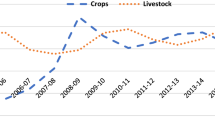Abstract
The classical theories of economic growth believe that production in the industrial sector is largely dependent on agriculture for contributing various factor inputs. Many theories have emerged supporting the phenomenal achievement in the Indian agriculture sector over the years. This chapter attempts to analyze the productivity growth in the Indian agricultural sector and provide a policy framework in the context of the profitability and sustainability of farming sector activities that employ two-thirds of India’s workforce.
Access this chapter
Tax calculation will be finalised at checkout
Purchases are for personal use only
Similar content being viewed by others
Notes
- 1.
According to estimation of nutrition experts, the average daily requirement of cereals for an average Indian adult is 412.2 grams. For pulses, it is estimated to be 67.95 grams per day. Total requirement for cereals in the year 1950–1951(with a population of 361 million) was 54.31 million tons while production was 42.42 million tons, accounting for a deficit of 11.89 million tons, which is 28% of total production. Similarly, for pulses, the requirement was 8.95 million tons whereas production was 8.41 million tons, accounting for a marginal deficit of 0.54 million tons. For total food grains, the requirement was 63.26 million tons while production was 50.83 million tons, accounting for a deficit of 12.42 million tons. This resulted in an increase in import of food grains on a large scale, accounting for the bulk of the import bill. In addition, food security was under threat. Conversely, in the year 2015–2016, the total food-grains requirement was 232.28 million tons (with population of 1326 million) whereas production was t 251.57 million tons with a surplus of 19.29 million tons. However, India still lacks in production of pulses. In 2015–2016, production was16.35 tons against a requirement of 32.88 tons, which led to imports of pulses.
References
Balkrishnan, P. (2000). Agriculture and economic reforms: Growth and welfare. Economic and Political Weekly, 35(12), 999–1004.
Balkrishnan, P., Golait, R., & Kumar, P. (2008). Agricultural growth in India since 1991. Department of Economic Analyis and Policy, Reserve Bank of India, Mumbai. Retrieved from https://rbidocs.rbi.org.in/rdocs/content/pdfs/85240.pdf
Denning, G., Kabambe, P., Sanchez, P., Malik, A., Flor, R., Harawa, R., et al. (2009, January 27). Input subsidies to improve small holder maize productivity in Malawi: Towards an African Green Revolution. PLOS Biology, 7(1), e23. https://doi.org/10.1371/journal.pbio.1000023
Dorward, A. (2009). Rethinking agricultural input subsidy programmes in a changing world. Centre for Development, Environment and Policy, SOAS, University of London. Retrieved from https://papers.ssrn.com/sol3/papers.cfm?abstract_id=1808847
Fan, S., Gulati, A., & Thorat, S. (2007). Investment, subsidies and pro-poor growth in rural India. IFPRI Discussion Paper 00716. Retrieved from https://ageconsearch.umn.edu/bitstream/42397/2/IFPRIDP00716.pdf
Grossman, N., & Carlson, D. (2011, March). Agriculture policy in India: The role of input subsidies. USITC Executive Briefings on Tradem. Retrieved from https://www.usitc.gov/publications/332/EBOT_IndiaAgSubsidies.pdf
Mahendra Dev, S. (2000). Economic reforms, poverty, income distribution and employment. Economic and Political Weekly, 35(10), 823–835.
Raghavan, M. (2008). Changing pattern of input use and cost of cultivation. Economic and Political Weekly, 43(26/27), 123–129.
Tripathi, A. K. (2013). Agricultural price policy, output and farm profitability – Examining linkages during post-reform period in India. Asian Journal of Agriculture and Development, 10(1), 91–111.
Author information
Authors and Affiliations
Corresponding author
Editor information
Editors and Affiliations
Rights and permissions
Copyright information
© 2019 The Author(s)
About this chapter
Cite this chapter
Panigrahi, R. (2019). Trends in Agricultural Production and Productivity Growth in India: Challenges to Sustainability. In: Rajagopal, Behl, R. (eds) Business Governance and Society. Palgrave Macmillan, Cham. https://doi.org/10.1007/978-3-319-94613-9_2
Download citation
DOI: https://doi.org/10.1007/978-3-319-94613-9_2
Published:
Publisher Name: Palgrave Macmillan, Cham
Print ISBN: 978-3-319-94612-2
Online ISBN: 978-3-319-94613-9
eBook Packages: Business and ManagementBusiness and Management (R0)




